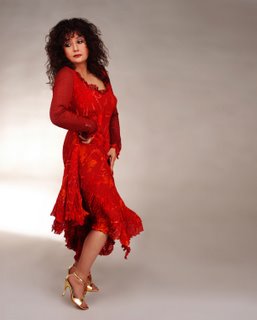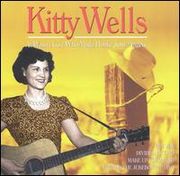[Intro]
Direct link to mp3.
Subscribe to Dreamtime
I'm doing another "someone who hasn't been featured on Theme Time yet," but like my prediction about Rick Nelson, I bet she will.
Maria Muldaur. Born Maria D'Amato, and raised in Greenwich Village, Maria was at ground zero for the Great Folk Scare of the '60s. Her first influences were country music singers, Hank Williams. Kitty Wells. Hank Snow. Ernest Tubb. When she was five years old, Maria liked to sing Kitty Wells' "It Wasn't God Who Made Honky Tonk Angels," complete with yodels.
After she finished high school, Muldaur moved to a loft in the Village and got involved with The Friends of Old Timey Music, a group that traveled the rural South to find legends like Doc Watson and Mississippi John Hurt, and then bring them north to present them in concert to urban audiences. "We used to have after hours jams on Saturday nights [in my loft], Maria said in an interview. Blues legends like the Reverend Gary Davis would come over and drink whisky, tell stories and play and sing. We'd stay up all night, then drive him up to Harlem, and without getting any sleep, he'd deliver a sermon. I found myself sitting at the feet of the Rev. Davis, Mississippi John Hurt, Son House and blues diva Victoria Spivey. It was an incredible time."
 After returning to New York from one of her visits to the South, Maria was invited to join The Even Dozen Jug Band, a group that included John Sebastian, and would eventually end up recording for the Elektra label. "We were paid $65 each for the record and played all of four gigs," Maria says. "Two of them at Carnegie Hall, one in a church and the other on the TV show, 'Hootenanny.' "
After returning to New York from one of her visits to the South, Maria was invited to join The Even Dozen Jug Band, a group that included John Sebastian, and would eventually end up recording for the Elektra label. "We were paid $65 each for the record and played all of four gigs," Maria says. "Two of them at Carnegie Hall, one in a church and the other on the TV show, 'Hootenanny.' "
The Even Dozen Jug Band soon dissolved, not least because most of its members were college-bound, and Muldaur migrated to Massachusetts to check out the Cambridge folk scene. In Cambridge, Maria would end up joining one of the most popular of the then very popular jug bands, The Jim Kweskin Jug Band. Except for the Muldaur connection, Kweskin and his jug band would be all-but-forgotten. The band disbanded in 1968, with several of its members, including Kweskin, joining a cult established by the jug band's ex-harmonica player, Mel Lyman. Lyman's other major claim to fame was for playing a long harmonica solo at the end of the 1965 Newport Folk Festival to the riled crowd streaming out after Dylan's famous electric outburst. But in the late `60s, after ingesting large and regular quantities of LSD, Lyman claimed himself at various times to be: the living embodiment of Truth, the greatest man in the world, Jesus Christ, and an alien entity sent to Earth in human form by extraterrestrials.
The `60s being the `60s, several people agreed with Lyman, including Jim Kweskin, and the band dissolved as Kweskin moved into The Mel Lyman Family. Happily, Maria, and her then-husband Geoff Muldaur, didn't, and they went on to become part of the Woodstock musical community. Geoff would leave Maria – both musically and their marriage – to form the Better Days Band, leaving his last name as his legacy.
"We had a friendly breakup, Maria says, "But I was left weeping in the driveway in Woodstock, a young woman with a five-year old kid. I went to our manager, Albert Grossman, and asked him for a job waitressing in one of his restaurants. I really had no vision of carrying on as a solo artist because for most of my adult life, my career had been tied to Geoffey as the musical mastermind. I was just a cooperative team player."
When Maria told Reprise Records president, Mo Ostin, that the duo he had signed to his label no longer existed,, Ostin's reaction was to offer her the opportunity to make her first solo album.
And of course, that album included the title hit, Midnight at the Oasis.
You can get Maria's full discography from that point at her web site, mariamuldaur.com, so I'm not going to get into that here. What I am going to get into is the knock-out album of Dylan love songs she released this August, Heart of Mine: Love Songs of Bob Dylan. If you haven't heard Heart of Mine, stop this podcast and whatever you're doing right now and go get it… it's one of the best collection of Dylan covers you're going to hear this or any other year. Maria turned 63 this September, but her voice, like Dylan's has aged like the finest wine. Here's Maria Muldaur doing a live version of Heart of Mine, taken from her show on the Woodsongs Old Time Radio Hour. I'll be talking about Wood songs more in the podcast, but first Maria Muldaur…
[Heart of Mine]
Maria Muldaur… there is nuthin' about that woman I don't like.
That live recording came from the Woodsongs Radio Hour, a live audience radio show broadcast over 400 radio stations, and with over 70 full-length shows, including the one with Maria Muldaur available for download. Go get Maria's – Show Number 415 – from Woodsongs.com.
This had been Fred Bals with the Dreamtime podcast – occasional commentary on Bob Dylan's Theme Time Radio Hour. Remember to come by and visit the Dreamtime podcast page. Just put "Dreamtime podcast" into Google and we'll be Number 1 on your hit parade.
Theme Time Radio Hour. Remember to come by and visit the Dreamtime podcast page. Just put "Dreamtime podcast" into Google and we'll be Number 1 on your hit parade.
Closing out tonight's show is Miss Kitty Wells doing the song Maria Muldaur liked to sing at age 5. "It Wasn't God Who Made Honky Tonk Angels" was an "answer song," in response to Hank Thompson's "The Wild Side of Life," Here's the 1952 hit that made Kitty Wells a star.
[It Wasn't God Who Made Honky Tonk Angels]
SiteSearch Google
Wednesday, November 08, 2006
Episode 20 – Heart of Mine
Posted by
Fred@Dreamtime
at
2:53 PM
![]()
Labels: Kitty Wells, Maria Muldaur, Woodsongs Old Time Radio Hour


No comments:
Post a Comment